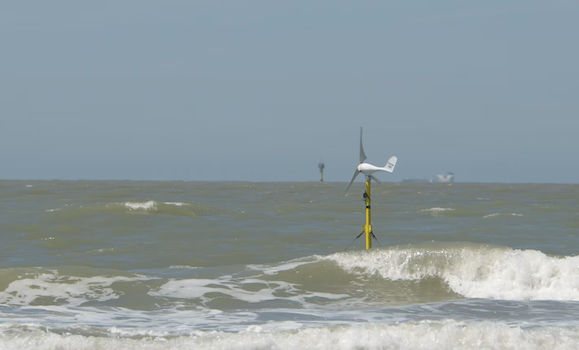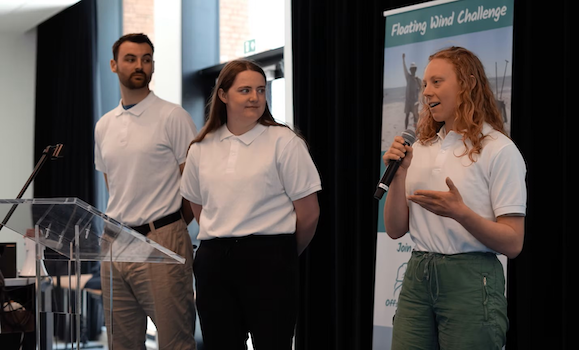A trio of ┬ÚÂ╣┤ź├Ż students and recent graduates earned international recognition this summer for their innovative offshore wind turbine design. ╠ř
╠ř
Despite being one of the smallest teams competing at the in Zeebrugge, Belgium, the team's inventive design and execution stood out in a highly competitive field, earning the challenge's bronze medal.
Andrew Ollerhead and Amy Kehoe, who recently completed their Mechanical and Electrical Engineering degrees, teamed up with Master of International Development Studies student Cara Cripton-Inglis to attend the competition against 13 university teams from around the world.
The teamÔÇÖs success comes at a pivotal moment for Nova Scotia, which recently became╠ř╠řThis groundbreaking decision highlights the provinceÔÇÖs commitment to expanding renewable energy and showcases how the ┬ÚÂ╣┤ź├Ż teamÔÇÖs turbine innovation could drive progress toward a cleaner, more sustainable energy future for the region.
The task at hand
╠ř

Each team was tasked with designing and fabricating a scaled model of a floating offshore wind turbine. The models are then tested in an ocean environment with judges evaluating everything from stability and power generation to the practicality of each design.
ÔÇťOf the turbines that were installed, I think we had the most difficult installation process because of the weight of our anchors and the complexity of our design,ÔÇŁ says Ollerhead.
Their winning turbine used a tension leg platform, a design that keeps the structure stable using tensioned chains anchored to the ocean floor. The approach isnÔÇÖt commonly attempted in student competitions.
ÔÇťThis was quite a feat given the fact that all installation had to be done by hand in 2-3 foot surf, and our team had three 125-pound moorings,ÔÇŁ adds Ollerhead. ÔÇťOn top of that, we were the smallest team at the competition (a team of 3), with several of the teams having 10-20 people.ÔÇŁ
In addition to placing third overall, the team also earned a secondary award for ÔÇťMost Efficiently Scalable DesignÔÇŁ and earned praise for their cost-efficient construction.╠ř

Qualifying for the challenge
╠ř
The opportunity to compete internationally came last fall when Ollerhead responded to a call for participants from Department of Mechanical Engineering. The regional qualifying round, hosted by the (COVE) in Dartmouth, invited students from post-secondary institutions across Atlantic Canada to design a floating turbine structure. The winning design would then advance to the international finals in Belgium.╠ř
ÔÇťWhat appealed to me about this competition was the opportunity to take the skills and knowledge introduced through coursework and apply them to a very hands-on project╠řÔÇö one that we would take all the way through the design process from initial conceptualization, to fabrication, to final assembly and testing,ÔÇŁ says Ollerhead.╠ř
Together with Kehoe and Cripton-Inglis, he began by developing the concept and CAD models and running simulations to test the viability of a tension leg platform. In January, the team headed into the machine shop to bring their concept to life with support of technicians.
ÔÇťThe work that the technicians do for the university community is too often overlooked. We really couldn't do any of this without them,ÔÇŁ he says. ÔÇťThe staff in the machine shop provided us with a lot of help and gave us many suggestions for best practices for fabrication. Following fabrication, we took the structure to the Aquatron╠řand the technicians there provided us with all of the resources we needed to conduct initial testing.ÔÇŁ╠ř
╠ř
The team tested their model at the regional competition last winter, successfully demonstrating the structureÔÇÖs performance and qualifying for the global finals in Belgium.╠ř

Collecting hands-on experience
╠ř
No stranger to the competition circuit, the 2025 Floating Wind Challenge marked OllerheadÔÇÖs sixth engineering competition during his studies. He says these events became his main extracurricular activity outside the classroom and gave him an opportunity to apply and grow his engineering skills in a hands-on, team-based setting.╠ř
╠ř
ÔÇťI think that all the work we do in the classroom is crucial but obviously thereÔÇÖs not a lot of opportunity to apply what you are learning in a tangible way when youÔÇÖre working behind a desk,ÔÇŁ he says. ÔÇťI think every student should be driven to join a team, whether that is a design team like the╠řFormula Society of Automotive Engineers (FASE) team or rocketry team, or any of a number of options.ÔÇŁ╠ř
╠ř
Since graduating from Dal Engineering, Ollerhead has been spending the summer in Newfoundland working with the Canadian Coast Guard through the Inshore Rescue Boat program. The seasonal role places crews in high-traffic boating areas to help keep recreational and commercial boaters safe on the water. ╠ř
╠ř
And after that?
ÔÇťAlthough this marks the end of my undergraduate studies and the associated competitions, this is likely not the end of the road for me academically,ÔÇŁ says Ollerhead. ÔÇÖI have been looking into masterÔÇÖs programs in the fields of aeronautical and marine engineering, two areas that have always been of interest to me.ÔÇŁ
Now read:

